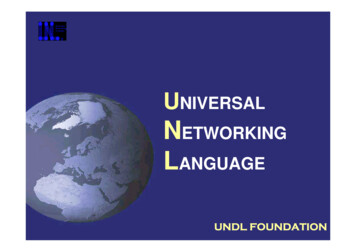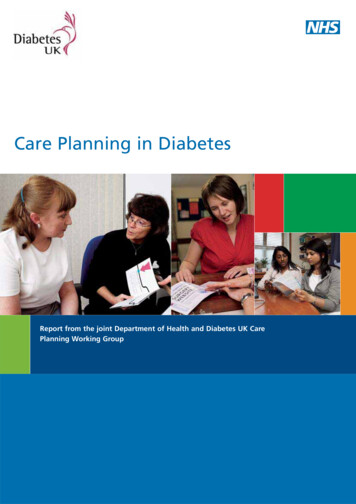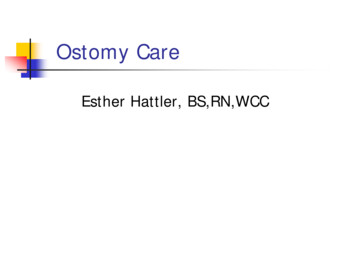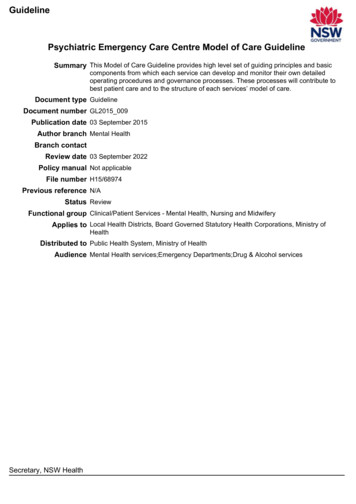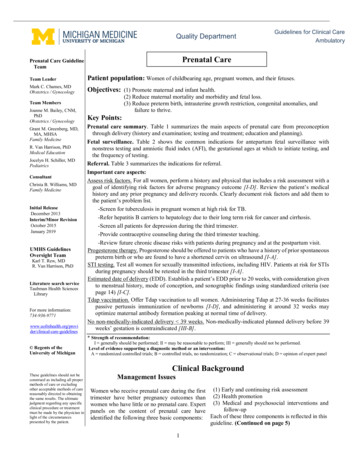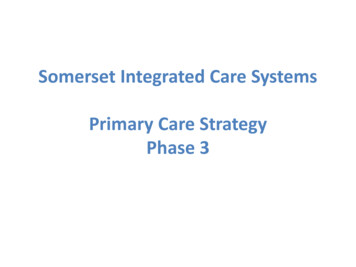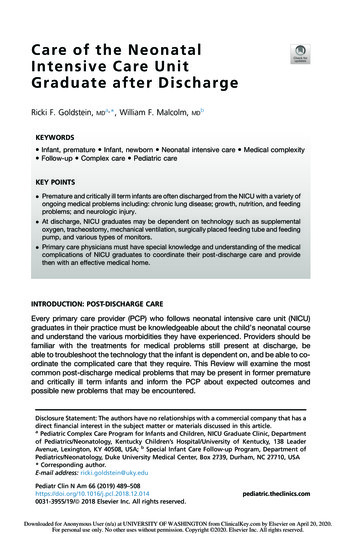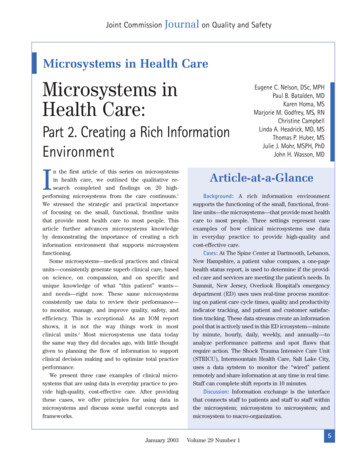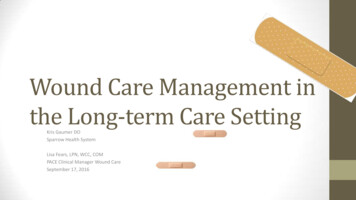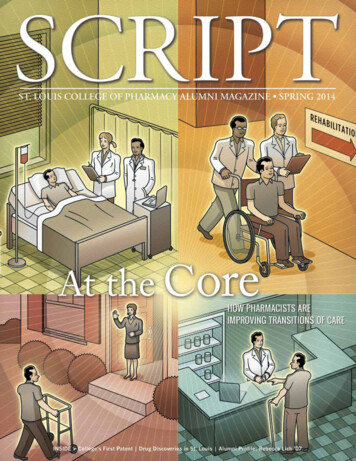
Transcription
The Universal Language of CareMembers of Lambda Kappa Sigma(LKS) service and professionalfraternity recently volunteeredat Health Protection Education Services’(HPES) free health clinic at the UniversityCity Public Library. They conductedglucose and blood pressure screenings,cholesterol checks, EKGs, and hearingand vision tests for underserved anduninsured patients.Fifth-year students Brooke Stanton,Grace Benanti, and Taylor Ashton andthird-year student Shelby Meyers alsocompiled a multilingual pharmacydirectory and introduced it at the clinic.According to HPES, participants inthe screenings are primarily AfricanAmerican, Chinese, or Korean and 25percent of the nonprofit’s clients arenon-English speaking or have limitedEnglish proficiency.PHOTOGRAPHS BY GREG KATSKIThe directory includes all of thepharmacies in the St. Louis metropolitanarea and indicates those with multilingual pharmacists. It also includes thename of each pharmacy, the pharmacy’saddress, normal hours of operation, andphone number. For each pharmacy, it liststhe employees that can speak or understand a particular language, their position,and shift hours. For more on this story,go to stlcop.edu/hpes.
Spring 2014ST. LOUIS COLLEGE OF PHARMACYSCRIPTV O L U M E2 4 ,N U M B E R1EditorSheila Haar SiegelDesignersJulie ConwayColleen KrutewiczContributing WritersStacy AustermanBrad BrownBlaire Leible GarwitzVicki HodderStephanie HoffmannGreg KatskiMary RiesProofreaderNancy BuschClass NotesKristine Bryant610President, Alumni AssociationBill Reed ’67Chairman, Board of TrusteesJane ArnoldPresidentJohn A. Pieper, Pharm.D.Vice President, AdvancementBrett T. Schott16Director, Alumni RelationsStephanie HoffmannAssistant Vice President,Marketing and CommunicationsBeth KeserauskisScript magazine is published threetimes a year for alumni, students,and friends of the College. Questionsor comments may be addressed toSheila Haar Siegel at shaar@stlcop.edu.22F E AT U R E SRelentless ResilienceShe doesn’t really tell anyone. Her STLCOP basketball coaches don’t evenknow about it (well, until now that is). Emily Nickels says she doesn’t letcystic fibrosis affect her life much. And once she makes up her mind, shedoesn’t change it.by sheila haar siegelTaking it FurtherProfessor John Beale’s discovery of four drug compounds—for whichhe has acquired the first international patent in the College’s history—may treat and even prevent Alzheimer’s disease and dementia.by sheila haar siegelAt the CoreTo decrease readmission rates to hospitals, reduce costs, and improve care,pharmacists are making sure they are at the center of the health care team,helping patients transition from one health care setting to another.by stacy austermanMade in St. LouisA look at some of the drugs discovered in St. Louis, the researchers behindthem, and the companies that developed and manufactured them.by vicki hodderADDRESS CHANGES ORTO UNSUBSCRIBEOffice of Advancement,314.446.8394 or alumni@stlcop.eduD E PA R T M E N T SST. LOUIS COLLEGE OF PHARMACYCollege Receptionist314.367.8700Script Magazine314.446.8397President’s Office314.446.8307Deans’ Office314.446.8342Admissions314.446.8312Financial Aid314.446.8320Alumni Office314.446.8419Public Relations314.446.8393Continuing Education314.446.8539W W W . S T L C O P. E D U / S C R I P T2News Briefs4On Campus: Places and Spaces14Faculty Profile: Shin-Yu Lee24Alumni Profile: Rebecca Lich ’0726Alumni News30Class Notes
News BriefsMarketing HonorsUMSL/August JenneweinJoint Business DegreesThe College has established a new collaborativeprogram with the University of Missouri-St. Louis(UMSL) that will allow student pharmacists to worktoward a graduate certificate in business administration or an Master of Business Administration (MBA)degree at UMSL while still enrolled at the College.“This agreement with UMSL is an incredible opportunity for our students,” says President John A. Pieper,Pharm.D. “The UMSL College of Business Administrationis a recognized leader in outstanding business education.By working together, we can give students an opportunity to expand their skills in business and management.”The College’s new curriculum will allow students todevelop an elective track in areas such as pharmacymanagement. “The curriculum exposes students tobusiness concepts,” says Ken Schafermeyer, Ph.D.,professor of pharmacy administration. “The ability togo even more in-depth in these important topics atUMSL will serve students well.”After students graduate from the College, they willbe able to continue classes at UMSL at their own pacein order to complete the graduate certificate or MBA.Graduate certificate courses include marketing, financialmanagement, communications, andaccounting. Some courses taken atthe College will be transferrable intoUMSL. Likewise, select courses takenat UMSL can be used to fulfill graduation requirements at the College.“As part of the College’s mission toprepare our students to positivelyimpact patients andsociety, we recognize theimportance and value agraduate certificate orMBA from UMSL provides,”Pieper says.2SPRING 2014The Office of Marketing andCommunications was recentlyhonored with two awards fromthe Council for Advancement andEducation (CASE) District VI.STLCOP received a silver award,in the category of Communications and Marketing Programs—Special Constituency Magazines— Research Magazines, for thefall 2012 issue of Script magazine.In addition, the College receiveda silver award, in the category ofIntegrated Advancement Programs—Web Sites—CompleteInstitutional Web Sites, forwww.stlcop.edu.Faculty Film DebutBrian Walter, associate professorof English and director of convocations, will present his documentary,Stay More: the World of DonaldHarington, at the Arkansas LiteraryFestival on April 27.In the 2013 feature-length film,Walter interviews American authorDonald Harington about theorigins of Stay More, the fictionalvillage in the Ozark Mountainswhere Harington’s novels areset. (The fictional town is based,somewhat, on Drakes Creek, Ark.,where Harington spent summersas a child.) Harington shares hismemories of the small town andtalks about the loss of his hearingdue to meningitis at the age of 12.CASE is a leading resource foreducational institutions and offersthe premier awards program formarketing, communications,fundraising, and alumni relationsactivities of CASE members.District awards honor everythingfrom annual reports to Web sitesto special events. More than 200colleges, schools, and universitiesare members of CASE District VI,whose eight-state region includesMissouri, Colorado, Iowa, Kansas,Nebraska, North Dakota, SouthDakota, and Wyoming.“Because he’d lost his hearing,it couldn’t be a conventionalQ and A,” Walter explains. “I wroteout questions beforehand, sentthem to him, and he would getfrustrated, even using the 3-by-5cards he had been using for yearsto field questions in his class.”Walter has written severalarticles, reviews, and fiction aboutthe author’s work and appears asan interviewer with trickyquestions in the last chapter ofHarington’s final novel, Enduring.Stay More: the World of DonaldHarington took several years tocomplete and Harington died, in2009, before it was completed(though he did get to see a trailerof the film).The firstpublic screeningof Stay More: theWorld of DonaldHarington willtake place onApril 12 at the ShilohMuseum of Ozark Historyin Springdale, Ark. Walterwill also speak on themaking of the documentary at the Books in BloomLiterary Festival in May.
News BriefsSTLCOP Takesthe CakeExpanding RotationsAround the GlobeSt. Louis College of Pharmacy and MekelleUniversity in Ethiopia have partnered tocreate an advanced pharmacy practiceexperience. Two sixth-year students, BryanBridgford and David Kim, were the firsttwo STLCOP students to travel to Ethiopiafor the new rotation.“We saw three to four cases of tuberculosis a day,” Bridgford says. “That’s notsomething you’d normally see here.”“The Mekelle University pharmacy program is pretty new, and faculty membersthere were looking for some assistancein establishing a Doctor of Pharmacyprogram,” says Goldie Peters, Pharm.D.,assistant professor of pharmacy practice.Peters visited Ethiopia three times in thelast year to help establish the partnership.“What impressed me the most was theattitude of compassion and sympathy byhealth care providers toward the patients,”Kim says. “I’m looking to start a career incommunity pharmacy after I graduate, andit was a great lesson to learn and apply it tomy future patients.”Students will have another opportunity to travel to Ethiopia early nextyear, and a faculty exchange programis also being considered. In themeantime, Peters is workingwith a team from Mekelle onthe university’s curriculumassessment andfeedback, especiallyon their experientialprogram. “We wentthrough some oftheir curriculumand compared itwith ours,” Peterssays. “They’vemade some significant progress, butnow we need tofigure out howto keep going.”A 4-foot-tall fiberglass birthdaycake has arrived on the campus ofSt. Louis College of Pharmacy. Thecake will be one of 250 displayed aticonic, quintessentially St. Louislocations to celebrate the city’s250th birthday.“This year St. Louis College ofPharmacy marks 150 years ofeducating future pharmacy innovators,” says President John A. Pieper,Pharm.D. “What better way tocelebrate our ses quicentennial andthe birthday of St. Louis than witha large cake for everyone to enjoy?”The location of 50 cakes wasdetermined by popular vote. Duringthe weeks of public voting, theCollege quickly moved from write-incandidate to the top of the leaderboard in the Innovation category,which celebrates the region’strail blazers who have made anindelible stamp on a local, national,and international level. After allthe votes were counted, the Collegesurpassed local icons like theGateway Arch, Saint Louis Zoo,and Ted Drewes FrozenCustard.“The College’sunique position withinthe medical center willensure this cake is seenby thousands everyday,” Pieper says. “I’mlook ing forward to seeingthe cake stand with us for such animportant year in our history.”The cake was installed oncampus March 17. As part of thecake’s interactive design, visitorswill be able to learn about the richhistory of the College, includinghow the College has been a pioneerin moving the profession ofpharmacy forward for 150 years.SCRIPT MAGAZINE3
Places and SpacesThere are buildings that have been renovatedand added over the years on campus.But soon there will be buildings that completelytransform STLCOP’s campus, culture, and stature.In March, the College broke ground on a new six-story,213,000-square-foot academic and research building andlibrary, located east of and in place of the current CartwrightStudent Center. The building’s design will be a highly visiblepresence in St. Louis’ world-class biomedical research andpatient care area.The building will house the School of Pharmacy and thefour-year professional Doctor of Pharmacy program. It willalso include technologically advanced classrooms andan auditorium, teaching laboratories, small group studyspaces, two floors of flexible wet and dry lab space, and awelcome center for prospective students and their families.The library will move to the new building and more thantriple in size. The advanced resource library will contain thelatest technological tools and research materials and willinclude space for group learning and individual study.The new facility will expand research labs with 30,000square feet devoted to research space. The space will facilitateimportant research discoveries that advance patient careand treatments in hospitals, clinics, and communitiesaround the world.The College has applied for LEED (Leadership in Energy andEnvironmental Design) certification from the U.S. GreenBuilding Council with the intention of generating as smalla carbon footprint as possible in constructing the building.In February 2013, the College’s Board of Trustees approveda campus master plan that called for a new academic andresearch building. The facility will support the College’svision of being globally prominent in health care education,interprofessional patient-centered care, and collaborativeresearch. Construction on the new building is scheduled forcompletion in June 2015.4SPRING 2014Go tostlcop.edu/constructionto get an inside look
On CampusSCRIPT MAGAZINE5
Student Profiletext
relentlessResilienceby sheila haar siegelphotos by jennifer silverbergLike most parents, Sue Nickels tookher daughter to the doctor for herregular checkups, expecting thebrief bout of ear-piercing criesand pea-sized tears from the mostrecent installment of recommendedvaccinations. Emily was two yearsold. Her mom was ready. Ready toscoop her up in her arms after theinitial sting of the shots wore off.But she wasn’t prepared for whatthe doctor ultimately found.
Student ProfiletextEmily had been losing weight and, asfirst-time parents, Mike and Sue Nickelswere keeping a close eye on her trajectory—making sure she was growingand developing at the pace of a normal2-year-old. Their family doctor (Emily’ssecond cousin) suggested some testing.Ironically, the physician’s specialty wasalso Emily’s diagnosis: cystic fibrosis.Her parents really didn’t knowmuch about the disease. They didn’tknow how to react. They just knew theywanted to make their little girl feelbetter. So they followed her doctor’sinstructions, pumping Emily full ofsupplements with every meal to boosther nutrition and caloric intake (cysticfibrosis can cause malnourishmentbecause the enzymes needed for digestion don’t reach the small intestine,preventing food from being absorbed).But, as it turned out, she didn’t need thesupplements.An inherited disease, cystic fibrosis(CF) affects the cells that producemucus, sweat, and digestive fluids.The fluids are normally thin and slippery. But in cystic fibrosis, a defectivegene causes the secretions to becomeunusually thick and sticky, pluggingup tubes, ducts, and passageways,8SPRING 2014Most people don’t even knowEmily Nickels has cystic fibrosis. HerSTLCOP basketball coaches don’tknow either (well, until now that is).especially in the lungs and pancreas.But Emily’s pancreas was working fine.She is “pancreatic sufficient,” whichoccurs in only 10 percent of peoplewith CF and means that her case ismilder than most. She is able to digesther food and doesn’t need to ingestpancreatic enzyme supplements.“Yeah, they didn’t know that untilI was in kindergarten,” Emily says, “Myparents suspected I was pancreaticsufficient and convinced the doctorsto perform additional tests to confirmit. So I don’t have the more severe typeof cystic fibrosis, so far at least knockon wood.”She still has to loosen the mucusin her lungs every day though, usingan inflatable vest that vibrates at highfrequency. Twice a day, she straps iton and hooks it up to a machine thatpounds her chest for 45 minutes at atime. It’s an itchy treatment, but notterribly painful.“It just takes time,” Emily says. “Mylungs are pretty good. When I want togo out and I have to do my medicine,it’s kind of annoying because I haveto wake up early to do it. Other thanthat, it’s not awful. Some people haveto do it three, four times a day.”She also inhales salt water (salinesolution) through a nebulizer twice aday to help keep her airways open. Butyou’d never know it. In fact, during highschool at Notre Dame in South St. LouisCounty, her teachers didn’t even knowshe had cystic fibrosis. She playedsoftball, basketball, golf, and soccer, butnone of her coaches had any inklingeither until her soccer coach was calledby a reporter from the St. Louis PostDispatch for an interview about Emilyand other local scholar-athletes.“I don’t really tell people,” Emilyexplains. “It really hasn’t impacted mylife that much. Some kids are alwayshospitalized, and I’ve only gone tothe hospital twice. And that was justbecause my mom wanted me to getextra medicine after my pulmonaryfunction test went down from 93 percentfunc tioning to 81. Otherwise, I’m prettymuch in the normal range of breathing.”In grade school, Emily was involved inswimming, volleyball, and anything elseher parents could think of. “Exercise isvery important for people with CF,” saysher father Mike, a civil engineer whohas become an expert on the diseaseafter asking laundry lists of questionsat doctor visits over the years, andwho is now working to find a cure as aboard member of the Gateway Chapterof the Cystic Fibrosis Foundation. “Agood cardio workout is as effective as atreatment and is an important part ofa CF patient’s daily health regimen.”Emily’s mom is a physical therapistand, to Emily, a 10-foot-tall person tolook up to. “I’m so much like her,” Emilysays. “I like hanging out with her, talking with her.” Neither of Emily’s parentshave cystic fibrosis, but both carry therecessive gene that causes CF. Emily’s11-year-old sister has also been diagnosed with the disease. Her 17-year-oldbrother does not have cystic fibrosis.Emily decided in the sixth grade thatshe wanted a career in the medical field.She knew she wanted to learn aboutmedicine and how it affects her, and tosee if she might be able to help otherswith cystic fibrosis. “Once I make upmy mind, I don’t change it,” she says.Her relentlessness has paid off. Nowa second-year student at the College,Emily is a 5’4” guard on the Eutectic
Student Profilebasketball team. HerSTLCOP coachesdon’t know abouther cystic fibrosiseither (well, untilnow, that is). Sheplays approximately20 games a seasonfrom Octoberthrough Februaryand practices fourdays a week, for anhour and a halfeach session. Yet shenever gets tired orout of breath.“I have too muchadrenaline,” shesays. “It’s just soexciting. By thevery end of a game, my muscles arejust dead, but I don’t think I’ve everbeen short of breath with a sport.”She also runs to keep herself intop physical shape—for basketballand her health. During her senioryear of high school, she won anExercise for Life Athletic Scholarship, a national scholarship fromthe Boomer Esiason Foundation, forrunning 1.5 miles in 10 minutes. Onlyone female student and one male student nationwide received the 10,000award, which went directly to covertuition costs at STLCOP last year.Emily currently works as a pharmacy technician at Neel’s Pharmacyin Crestwood and, eventually, hopesto practice pharmacy in ambulatorycare, working with patients who haveCF. “My cystic fibrosis will probablymake me more understanding of howmedicine keeps you healthy,” she says.“For me, I don’t want to lose lungfunction, because I won’t get it back.I want to keep on top of it and makesure I maintain it.”And as Emily knows better thanmost, improvements in treatmentsand care are increasing the averagelife span, every year, for children andadults with cystic fibrosis. In the 1950s,few children with the disease lived toattend elementary school. Today, thepredicted median age of survival for aperson with CF is in the early 40s. Manypeople with the disease can now expectto live into their 30s, 40s, and beyond.In 2012, the U.S. Food and DrugAdministration approved a drug thatmay correct the underlying defectivegene in four percent of people who haveespecially rare mutations of cysticfibrosis. Another drug, currently in“I know most people diefrom cystic fibrosis whenthey’re 38.I have a rare formof the disease, so we’ll see.I’m like the test dummy.”phase III clinical trials, may help withthe most common mutation, whichaffects 90 percent of CF patients. Asecond generation of similar, but morepotent, medications is headed to phase Itrials later this year. It’s early, but theresults are encouraging.“I know most people die from cysticfibrosis when they’re 38,” Emily admits.“But there are some people who live toage 60, which is good. I have a rare formof the disease, so we’ll see. I’m like thetest dummy. But long term yeah,hopefully it’s good.”SCRIPT MAGAZINE9
FeatureTaking
(UMSL) that will allow student pharmacists to work toward a graduate certificate in business administra-tion or an Master of Business Administration (MBA) degree at UMSL while still enrolled at the College. “This agreement with UMSL is an incredible opportu - nity f
